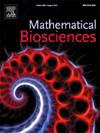Dynamics of phase tumbling and the reentrainment of circadian oscillators
IF 1.8
4区 数学
Q2 BIOLOGY
引用次数: 0
Abstract
Circadian clocks are comprised of networks of cellular oscillators that synchronize to produce endogenous daily rhythms in gene expression and protein abundance. These clocks have evolved to align the physiology and behavior of organisms to the 24-h environmental cycles arising from Earth’s rotation. Rapid travel across time zones causes misalignment between an organism’s circadian rhythms and its environment, leading to sleep problems and other jet lag symptoms until the circadian system entrains to the external cycles of the new time zone. Experimental and modeling work has shown that phase tumbling, defined as desynchronizing networks of circadian oscillators prior to an abrupt phase shift of the light-dark cycle, can speed up the process of reentrainment. Here, we use a mathematical model of circadian oscillators and 2-D entrainment maps to analyze the conditions under which phase tumbling has a positive, neutral, or negative effect on reentrainment time. We find that whether or not phase tumbling is beneficial depends on the size of the external phase shift and the location of the perturbed oscillator with respect to the fixed points and invariant manifolds of the entrainment map.
相位翻滚的动力学和昼夜节律振荡器的重携。
昼夜节律钟由细胞振荡器网络组成,它们同步产生基因表达和蛋白质丰度的内源性日节律。这些时钟的进化使生物的生理和行为与地球自转产生的 24 小时环境周期保持一致。快速的时区旅行会导致生物体的昼夜节律与环境不一致,从而引起睡眠问题和其他时差症状,直到昼夜节律系统适应新时区的外部周期。实验和建模工作表明,"相位翻滚"(即在光-暗周期的突然相位转换之前使昼夜节律振荡器网络失去同步)可以加快重新适应的过程。在这里,我们使用昼夜节律振荡器数学模型和二维诱导图来分析相位翻滚对再诱导时间产生积极、中性或消极影响的条件。我们发现,相位翻滚是否有益取决于外部相位偏移的大小以及受扰动振荡器相对于夹带图定点和不变流形的位置。
本文章由计算机程序翻译,如有差异,请以英文原文为准。
求助全文
约1分钟内获得全文
求助全文
来源期刊

Mathematical Biosciences
生物-生物学
CiteScore
7.50
自引率
2.30%
发文量
67
审稿时长
18 days
期刊介绍:
Mathematical Biosciences publishes work providing new concepts or new understanding of biological systems using mathematical models, or methodological articles likely to find application to multiple biological systems. Papers are expected to present a major research finding of broad significance for the biological sciences, or mathematical biology. Mathematical Biosciences welcomes original research articles, letters, reviews and perspectives.
 求助内容:
求助内容: 应助结果提醒方式:
应助结果提醒方式:


